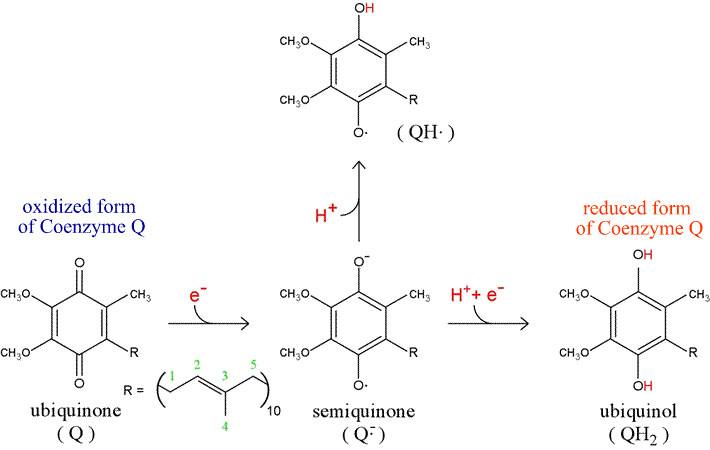Ubiquinone is 2,3-dimethoxy-5-methyl-6-multiprenyl-1, 4-benzoquinone, also known as CoEnzyme Q (CoQ10, Q). The reduced form (QH2) is called ubiquinol and the partially reduced free-radical form is called semiquinone. The quinone group allows CoEnzyme Q to function as an electron-carrier, while the highly hydrophobic tail of isoprene units helps to confine CoEnzyme Q to lipid-rich areas of cells. In most species the number of isoprene units is between 6 and 10. CoEnzyme Q in mammals either has 9 (CoQ9) or 10 (CoQ10) isoprene units. In mouse and rat nearly 90% of ubiquinone is CoQ9, whereas rabbit, pig, goat, sheep, cow and horse have predominantly CoQ10, with 4% or less of CoQ9. CoQ10 is also predominant in guinea pigs and humans.
 Figure 1. Structure of ubiquinone
Figure 1. Structure of ubiquinone
CoQ is the only component of the electron transport chain that is lipid rather than protein, and CoQ is the only component that is not anchored to the inner mitochondrial membrane. CoQ is so hydrophobic, in fact, that it usually shuttles back and forth laterally in the middle of the phospholipid bilayer without getting close to the polar phosphate groups on the edges of the membrane. CoQ picks up reducing equivalents from protein Complex I and protein Complex II and shuttles these "electrons" (as CoQH2 = QH2) to protein Complex III and then returns (as CoQ = Q) to get more reducing equivalents (the "Q cycle").
Normally most of the CoEnzyme Q is in reduced form (ubiquinol, QH2), which is the form that is most effective as an anti-oxidant. The ubiquinol can neutralize a lipid peroxyl radical by donating one of its hydrogen atoms to become the free-radical semiquinone, which is then restored to a non-free-radical state by the respiratory chain Q cycle. Vitamin E is actually more effective as a mitochondrial membrane anti-oxidant than is CoEnzyme Q because Vitamin E neutralizes lipid peroxyl radicals far more readily and because Vitamin E is less hydrophobic, allowing it to more freely move throughout the mitochondrial membrane. CoEnzyme Q is more confined to the center of the phospholipid bilayer. But Vitamin E tocopheroxyl radical should be neutralized to prevent it from causing oxidative damage. And unlike CoEnzyme Q, which is synthesized in the cell, Vitamin E must be obtained from the diet.
Although 80% of CoEnzyme Q is found in mitochondria, its presence in microsomes, Golgi apparatus and plasma membranes indicates its importance as an endogenously produced lipid-phase antioxidant. Even in mitochondria, up to a third of CoEnzyme Q is bound to mitochondrial membrane proteins, apparently to serve primarily as an antioxidant. Long-lived mammalian species show a greater proportion of mitochondrial membrane-associated CoEnzyme Q than short-lived species.
CoQ10 has a history as an adjunctive agent in the treatment of cardiovascular disease. In 1974 CoQ10 was approved in Japan as a treatment of congestive heart failure. Clinical trials have shown CoQ10 to improve heart workload capacity and ejection fraction. Vascular oxidative stress that converts nitric oxide to peroxynitrite results in endothelial dysfunction due to reduced availability of nitric oxide for vascular smooth muscle relaxation. By preserving nitric oxide, CoQ10 reduces vasoconstriction and thereby lowers blood pressure. Animal and human studies have demonstrated reduction in blood pressure (and reduced requirement for anti-hypertensive drugs) with CoQ10. CoQ10 supplementation is associated with few adverse effects. But because CoQ10 is a natural substance that cannot be patented, there is little financial incentive for research or for large clinical trials to justify its therapeutic benefits.
Currently, a reliable and reproducible method using highly sensitive HPLC-MS platform for the rapid identification and quantification of ubiquinone in different sample types has been established by the experienced scientists at Creative Proteomics, which can satisfy the needs of academic and industrial study in your lab.
Summary
- Identification and quantification of ubiquinone.
Report
- A detailed technical report will be provided at the end of the whole project, including the experiment procedure, instrument parameters.
- Analytes are reported as uM or ug/mg (tissue), and CV's are generally<10%.
- The name of the analytes, abbreviation, formula, molecular weight and CAS# would also be included in the report.
With integrated set of separation, characterization, identification and quantification systems featured with excellent robustness & reproducibility, high and ultra-sensitivity, Creative Proteomics provides reliable, rapid and cost-effective ubiquinone targeted metabolomics services.
How to place an order:

*If your organization requires signing of a confidentiality agreement, please contact us by email.